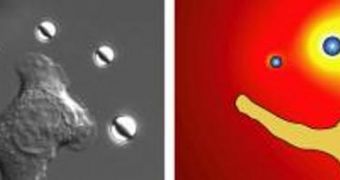The vast majority of bacteria, microbes and viruses entering our bodies have a very short-lived existence. They are immediately picked up by the immune system, which sends its killer cells to deal with the problem. Only highly-adapted, very tough bugs endure, such as MRSA and HIV. Common ones die off within a few days at most. Researchers have always been fascinated about how the immune system and its cells work, and they have been studying the mechanisms through which it is activated extensively. At a recent conference, a team presented new findings in this field.
Speaking in Edinburgh, at the spring meeting of the Society for General Microbiology, expert Dr Holger Kress, who is based at the Yale University, says that he and his group managed to devise a new system of analyzing how immune cells track down and destroy invaders. The team has devised a cunning setup, in which they use microscale particles to mimic pathogens. They are then placed in a solution with immune cells, and researchers observe what happens. Scientists already know that killer cells tend to follow the trail of chemicals that bacteria for example leave behind as they invade.
This was also evidenced in the new research. But the researchers, which included Yale professor Eric Dufresne as well, devised a method of controlling the shape of the chemicals their micro particles shedded. They employed the help of optical tweezers, highly-advanced manipulation devices that employ laser beams to actively control the motions of a particle, with a degree of accuracy as high as one millionth of a millimeter.
“By controlling the shape of the chemical signals, we were able to control the movements of immune cells and study how they respond to the signals,” Dr Kress said at the meeting. He added that immune cells also proved to be incredibly sensitive to invaders. Just a single micro particle was enough to trigger the defense cells known as neutrophiles into action. They immediately began actively seeking the intruder in order to eliminate it. “This new technique allows us to measure systematically how cells respond to various stimuli over minute gradients in time and space,” the expert added.
“Cell migration along chemical gradients of this kind plays a key role in wound healing and the wiring of the brain. It is also an essential feature of many diseases – particularly metastatic cancers,” Kress explained. Using chemical manipulation, it may become possible in the future to control the motions of immune system cells, directing their attacks in whichever way is indeed in a particular case.

 14 DAY TRIAL //
14 DAY TRIAL //